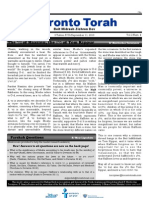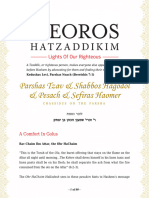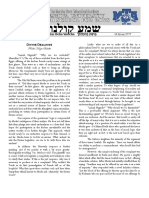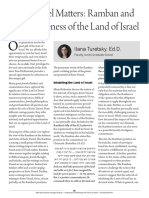Toronto Toronto Torah Torah
Uploaded by
outdash2Toronto Toronto Torah Torah
Uploaded by
outdash2בס“ד
Toronto Torah Beit Midrash Zichron Dov
Parshat Va‟etchanan/Nachamu 13 Av 5770/July 24, 2010 Vol. I Num. 41
Tu b’Av: The Holiday of Hitting Rock Bottom R’ Mordechai Torczyner
The hoariest of hoary Jewish jokes describes that a tribe didn‟t plummet from the punishment for the Golden Calf is
the plot of the Jewish holiday as, “They tried precipice of extermination, that murdered postponed for an undefined future (Shemot
to kill us, we survived, let‟s eat.” The point soldiers were interred? How could the 32:34), while the punishment for the Spies
could be challenged regarding most of our Talmud (Taanit 30b) identify this as the ends after forty years. This is also why the
national celebrations, but for this Sunday‟s “best day on the calendar,” above Pesach, Talmud (Sotah 9a) takes comfort in the
holiday, Tu b‟Av [the 15th of Av], out-running above Shavuot, even above Succot with its Divine malediction, “I will finish My arrows
our enemies actually seems to define the title of “Zman Simchateinu - the time of our upon them,” for even though G-d will launch
day. joy?” many arrows at us, there will be a finish and
conclusion, and yet we will survive and be
The gemara (Taanit 30b-31a) lists seven The answer may be that “best day” does not redeemed.
reasons to celebrate Tu b‟Av, and three of necessarily equal “happiest day.” We
them offer the underwhelming applause celebrate many happy days, including the On Tu b‟Av we recognize that the
line, “We didn‟t die!”: aforementioned Shalosh Regalim, but Tu punishment for the sin of the Spies is over.
b‟Av is not a day of joy. Tu b‟Av is a good On Tu b‟Av we recognize that the threat to
HaShem informed the Jews who had day, the best day – because on Tu b‟Av we the tribe of Binyamin has passed. On Tu
listened to the Spies that they would hit rock bottom. b‟Av we recognize the conclusion of Roman
perish in the desert, over a period of 40 aggression. There is no joy in these bitter
years. Annually, a segment of that The greatness of hitting rock bottom may be recognitions, but there is the empowering,
population passed away on Tishah b'Av, best explained through a comment by Rav invigorating, rejuvenating hope that from
until the year finally came when the full Chaim Vital, as cited in Rav Dovid these depths we will ascend and emerge.
moon shone on Tu b‟Av and yet no one Eibeschutz‟s Arvei Nachal (Behar, Derush
had passed on. Their failure to expire is 2): R‟ Menachem Meiri saw this message of
our cue to strike up the band. (See hope, too, in the abrupt talmudic transition
ש מי שידע שיעור המדריגות וישער איך ירידת
Tosafot Taanit 30b for more on this.) יוכל לידע מתי,המדריגות בכל יום ויום תרד פלאים from discussing Tishah b'Av to discussing Tu
כי כאשר שחה לעפר נפשנו דבקה לארץ,קץ הגאולה b‟Av:
After a woman was tortured and כז) כי- כו,בטננו אז קומה עזרתה לנו (ע' תהלים מד
לבאר שאין להתיאש לרוב הצרות אבל כל אשר יענו
murdered in the territory of Binyamin, כאשר תפול כל כך עד סוף שאין מקום עוד ליפול
עה"פ. אז היא הגאולה של בעתה (סנהדרין צח,יותר .אותנו כן נרבה בהיות ד' אתנו בלכתנו בדרכיו
the Jewish national army took up their
ב) נפלה, כמו שאמר הכתוב (עמוס ה,)ישעיה ס כב To show that we should not lose hope under
weapons against that tribe. The war ר" ל כאשר נפלה כל כך עד שלא תוסיף,ולא תוסיף
decimated Binyamin, and it was followed עוד ליפול דהיינו נפילה לארץ שהיא סופה דכל the strain of our troubles. However much
by a decree lest any woman from . אז קום בתולת ישראל,דרגין they oppress us, so we will multiply, as long
outside Binyamin marry any of their as HaShem will be with us, as we follow His
males. The tribe teetered on the brink of One who knows the measure of the levels path."
extermination, until the decree was [to the bottom], and who can measure our
revoked on Tu b‟Av – another trigger for shocking daily descent, can know when the We are taught (Nedarim 39b) that G-d
joy and celebration. (See Shoftim 19-21 moment of redemption will arrive. After our created the possibility of teshuvah, of return
for additional information.) soul will descend to the dust and our belly to G-d, even before creating this universe.
will stick to the ground, then G-d will rise Teshuvah is more fundamental than the
Approximately sixty years after the and help us, for when the nation falls until fundamental elements of our world, more
Second Temple was destroyed, our there is no more room to fall, then will come natural than nature itself. This is true even
ancestors revolted against Roman the redemption described by G-d as after the dramatic descent of Tishah b'Av,
tyranny. The Romans crushed their coming „at its proper time.‟ It is written and it is the theme of the best day on our
revolt and demolished the mighty (Amos 5:2), „She has fallen, and she will not calendar.
fortress at Betar, murdering thousands. continue,‟ meaning that when the Jewish When Moshe ascended Mount Sinai, he
For years thereafter, Roman authorities nation has fallen so far that she cannot fall entered a cloud which the Torah describes
refused to allow the Jews to bury their further, meaning she has fallen to the as “Arafel,” utter darkness. Moshe entered
dead fighters; Tu b‟Av was the day when ground, the end of all levels, then [G-d will this Arafel, because, “Asher Sham
we were able to bury the dead of the say], „Rise, betulah of Israel.‟” ha‟Elokim,” “that‟s where HaShem is.”
Betar revolt. We held funerals for the In other words: Hitting rock bottom is a When the Jews go through the three weeks
miraculously preserved remains of our positive experience because we are of mourning, when we endure a Tishah b'Av,
heroes, and this, too, is cause for an promised that it will be followed by we are in the Arafel, we are in the darkness
annual national festival. redemption. – but so is HaShem. And the 15th of Av
Normal nations celebrate birthdays, promises that having hit bottom, we will
This is why the punishment for the Golden always emerge, with HaShem, from that
anniversaries, revolutions – would anyone Calf is considered worse than the Arafel.
other than a Jew institute a holiday to punishment for the Spies – because the
celebrate that his ancestors stopped dying, torczyner@torontotorah.com
Tefillah, Torah Study and Kriyat Shma R’ Azarya Berzon
Many fundamental mitzvot are taught in 2) A second connection between Torah (accepting the sovereignty of HaShem),
our parsha. I would like to discuss and T’filla is reflected in the statement of as the Gemara tells us in Brachot, 14a:
various aspects of Torah study, T’filla, Abaye in Brachot, 8a, that one should
and Kriyat Shema. The insights I will R‟ Yochanan said: one who wishes
pray in the place he studies Torah. Based to accept upon himself the yolk of
share with you are based on the shiurim on the pasuk in Tehilim (87:2), “HaShem
of my Rebby, HaRav Rabbi Yosef Dov HaShem‟s Kingship in a perfect
loves the gates of Tzion”, Rav Chisda way, should follow the following
Soloveichik, zatz”al, and are relevant to states:
פרשת ואתחנן. order: he should [wake up and]
HaShem loves the gates of [the study relieve himself, wash his hands, don
I) The Relationship Between Torah Study of] Halacha even more than the gates his T’fillin, recite Kriyat Shema and
and T’filla of the synagogue. pray. This is complete Kabalat Ol
In a number of statements of Chaz”al, we 3) The Rambam in his Sefer HaMitzvot Malchut Shamayim.
find that the mitzvot of Torah study and (Mitzvat Aseh #5) quotes the very same 2) Torah Study. The study of Torah also
T’filla go together: Biblical source for both the mitzvah of contains within it a fulfillment of Kabalat
1) The Gemara in Berachot, 31a, quotes T’filla and the mitzvah of Torah study. The Ol Malchut Shamayim. The Rambam,
two braitot regarding T’filla. The first pasuk in Dvarim (11:13), “And you shall Hilchot Kriat Shema, 1:2, defines the
braita states: serve HaShem with all your heart and all various elements of Kabalat Ol Malchut
your soul” is for the Rambam, the Biblical Shamayim in the recitation of Kriyat
“One should stand in prayer following
source for the obligation to pray. The Shema:
[the study of] Halacha p’suka (Jewish
Rambam writes: We start with the parsha of Shema
law).”
The language of the Sifri (on this [before the second and third
The second braita states:
verse) is: “And you shall serve Him, parshiot that are recited] because
“One should stand in prayer following the this refers to prayer.” The Sifri further Shema contains the unity of God
joy of a mitzvah”. states, “And you shall serve Him, this (Yichud HaShem), the love of
Rashi explains that according to the refers to study...serve Him with His HaShem (Ahavat Hashem), and the
second braita, before one davens, he Torah, and in his Mikdash. study of His Torah, which is the
should read sections of Torah, for We can derive a fundamental conclusion great foundation (ikkar hagadol)
example: the Exodus from Egypt or from the Rambam. Service of the heart upon which all rests.
Ashrei from Psalms, which contain (avodah she’balev) consists of two That Torah study generates a kiyum of
psukim which express HaShem‟s elements: T’filla and Torah. Through the Kabalat Ol Malchut Shamayim can be
relationship and concern for His people. study of Torah, one fulfills his obligation proven from the custom of reciting
According to both braitot one must read of avodah she’balev, just as he does so kaddish d’Rabbanan following the study
from the Torah prior to his T’filla. The through T’filla. Torah study and prayer of Torah. This Kaddish is a dramatic
difference is that whereas the first braita are integrated to form a unit of avodah expression of accepting the kingship of
requires the study of Torah She’bal Peh she’balev. HaShem upon ourselves.
(the Oral Torah), the second prefers the
We can understand the relationship Thus, the study of Torah is the expression
recitation of Torah She’Bichtav (the
between Torah study and prayer if we of one‟s commitment to HaShem and His
written Torah), specifically psukim which
establish the underlying purpose of both. Torah, and is a fulfillment of avodah
express ideas of consolation and
1) T’filla is an integral part of the mitzvah shebalev. (See Shiurim le‟Zecher Abba,
encouragement.
of Kabalat Ol Malchut Shamayim Vol. II, p. 7-8) abezon@torontotorah.com
Schedule for the Summer, July 24-August 20
Shabbat, July 24, 31, August 14
7:50AM R‟ Azarya Berzon: Ramban al haTorah, Or Chaim
After Hashkamah: R‟ Azarya Berzon, Clanton Park
One Hour Before Minchah: R‟ Azarya Berzon: Masechet Kiddushin, Mizrachi Bayit Cancelled July 31
One Hour Before Minchah: Russell Levy: Daf Yomi, Bnai Isaac, Baysville Will be delivered on August 7
Sunday, Weekly through September 5; Monday, August 2; Monday, September 6
8:30AM Russell Levy: Daf Yomi, Bnei Isaac, Baysville
9:00AM Russell Levy: Practical Halachah at the Cottage, Bnei Isaac, Baysville Come join us for Slichot on the
Sunday, July 25, August 15
Lake at Bnei Isaac in Baysville for
7:30PM R‟ Azarya Berzon: Masechet Kiddushin, Shaarei Shomayim the first night of slichot, Sunday
September 5. Email Russell Levy at
Monday, July 26, August 16
7:30PM R‟ Azarya Berzon: Hilchot Talmud Torah, Clanton Park
rlevy@torontotorah.com for more
9:15PM R‟ Azarya Berzon: Ramban al haTorah information.
Tuesday, July 26, August 17
7:30PM R‟ Azarya Berzon: The New Method of Rationalization of Mitzvot, BAYT, West Wing Classroom #1
Wednesday, July 27, August 18
8:30PM R‟ Azarya Berzon: Shiur Highlights
Thursday, July 28, August 19
7:50PM R‟ Azarya Berzon: Halachah and Life Issues, Clanton Park Men
You might also like
- Lessons Learned From Conversion: Rabbi Zvi RommNo ratings yetLessons Learned From Conversion: Rabbi Zvi Romm5 pages
- Parashah 51: Nitzavim "Standing ": YHVH's Covenant Extended To All NationsNo ratings yetParashah 51: Nitzavim "Standing ": YHVH's Covenant Extended To All Nations8 pages
- Simchah Shel Mitzvah: Rabbi Moshe LichtmanNo ratings yetSimchah Shel Mitzvah: Rabbi Moshe Lichtman2 pages
- Consent and Coercion at Sinai: Rabbi Dr. Jacob J. SchacterNo ratings yetConsent and Coercion at Sinai: Rabbi Dr. Jacob J. Schacter3 pages
- The Clouds of Glory and The Power of Prayer: ShemotNo ratings yetThe Clouds of Glory and The Power of Prayer: Shemot4 pages
- Bob Marley Hudade To Fasika Rastafari Sabbath Meditation MusicNo ratings yetBob Marley Hudade To Fasika Rastafari Sabbath Meditation Music18 pages
- Revue Des Études Juives. 1880. Volume 58.No ratings yetRevue Des Études Juives. 1880. Volume 58.332 pages
- Igbo Torah Commentary Rabbi Yehudah "Tochukwu" Ben ShomeyrNo ratings yetIgbo Torah Commentary Rabbi Yehudah "Tochukwu" Ben Shomeyr10 pages
- How To Make This Our Last Tisha B'av: Rabbi Lawrence HajioffNo ratings yetHow To Make This Our Last Tisha B'av: Rabbi Lawrence Hajioff4 pages
- Source Material For R Aharon Rakeffet S Shiurim On Responsa Literature (Conditional Divorce & Other Israeli Army Issues)No ratings yetSource Material For R Aharon Rakeffet S Shiurim On Responsa Literature (Conditional Divorce & Other Israeli Army Issues)60 pages
- Being Wise of Heart: Volume XIII - Issue 11 The DRS Weekly Torah PublicationNo ratings yetBeing Wise of Heart: Volume XIII - Issue 11 The DRS Weekly Torah Publication8 pages
- Second Advent Review,: and Sabbath HeraldNo ratings yetSecond Advent Review,: and Sabbath Herald8 pages
- From Bondage To Bonding: Rabbi Benajmin YudinNo ratings yetFrom Bondage To Bonding: Rabbi Benajmin Yudin3 pages
- Prepare Yourselves For The Great Day of The Lord Benson - Ezra - 1981 - 04No ratings yetPrepare Yourselves For The Great Day of The Lord Benson - Ezra - 1981 - 047 pages
- The Story Behind The Laws: 29 Shevat, 5777/february 25, 2017 Parshat Mishpatim/Shekalim Vol. 8 Num. 25No ratings yetThe Story Behind The Laws: 29 Shevat, 5777/february 25, 2017 Parshat Mishpatim/Shekalim Vol. 8 Num. 254 pages
- Advent Review and Sabbath Herald - October 4, 1945No ratings yetAdvent Review and Sabbath Herald - October 4, 194524 pages
- Thomas Bromley (Philadelphian) - The Great and Gradual Work of Regeneration-Part2No ratings yetThomas Bromley (Philadelphian) - The Great and Gradual Work of Regeneration-Part230 pages
- Continental Monthly, Vol. III, No IV, April 1863 Devoted to Literature and National PolicyFrom EverandContinental Monthly, Vol. III, No IV, April 1863 Devoted to Literature and National PolicyNo ratings yet
- Funeral Service For Katherine Cheavens HargoveNo ratings yetFuneral Service For Katherine Cheavens Hargove25 pages
- Lessons From Mount Sinai:: The Interplay Between Halacha and Humanity in The Gerus ProcessNo ratings yetLessons From Mount Sinai:: The Interplay Between Halacha and Humanity in The Gerus Process3 pages
- Tisha Be'Av: Shabbat Devarim Shabbat 28 July 2012 9 Ab 5772No ratings yetTisha Be'Av: Shabbat Devarim Shabbat 28 July 2012 9 Ab 57725 pages
- The Surrogate Challenge: Rabbi Eli BelizonNo ratings yetThe Surrogate Challenge: Rabbi Eli Belizon3 pages
- Flowers and Trees in Shul On Shavuot: Rabbi Ezra SchwartzNo ratings yetFlowers and Trees in Shul On Shavuot: Rabbi Ezra Schwartz2 pages
- The Meaning of The Menorah: Complete Tanach)No ratings yetThe Meaning of The Menorah: Complete Tanach)4 pages
- The Matan Torah Narrative and Its Leadership Lessons: Dr. Penny JoelNo ratings yetThe Matan Torah Narrative and Its Leadership Lessons: Dr. Penny Joel2 pages
- Performance of Mitzvos by Conversion Candidates: Rabbi Michoel ZylbermanNo ratings yetPerformance of Mitzvos by Conversion Candidates: Rabbi Michoel Zylberman6 pages
- Shavuot To-Go - 5777 Mrs Schechter - Qq4422a83lNo ratings yetShavuot To-Go - 5777 Mrs Schechter - Qq4422a83l2 pages
- I Just Want To Drink My Tea: Mrs. Leah NagarpowersNo ratings yetI Just Want To Drink My Tea: Mrs. Leah Nagarpowers2 pages
- Reflections On A Presidential Chavrusa: Lessons From The Fourth Perek of BrachosNo ratings yetReflections On A Presidential Chavrusa: Lessons From The Fourth Perek of Brachos3 pages
- What Happens in Heaven... Stays in Heaven: Rabbi Dr. Avery JoelNo ratings yetWhat Happens in Heaven... Stays in Heaven: Rabbi Dr. Avery Joel3 pages
- Why Israel Matters: Ramban and The Uniqueness of The Land of IsraelNo ratings yetWhy Israel Matters: Ramban and The Uniqueness of The Land of Israel5 pages
- Kabbalat Hatorah:A Tribute To President Richard & Dr. Esther JoelNo ratings yetKabbalat Hatorah:A Tribute To President Richard & Dr. Esther Joel2 pages
- Experiencing The Silence of Sinai: Rabbi Menachem PennerNo ratings yetExperiencing The Silence of Sinai: Rabbi Menachem Penner3 pages
- Chag Hasemikhah Remarks, 5777: President Richard M. JoelNo ratings yetChag Hasemikhah Remarks, 5777: President Richard M. Joel2 pages
- José Faur: Modern Judaism, Vol. 12, No. 1. (Feb., 1992), Pp. 23-37No ratings yetJosé Faur: Modern Judaism, Vol. 12, No. 1. (Feb., 1992), Pp. 23-3716 pages





















































































